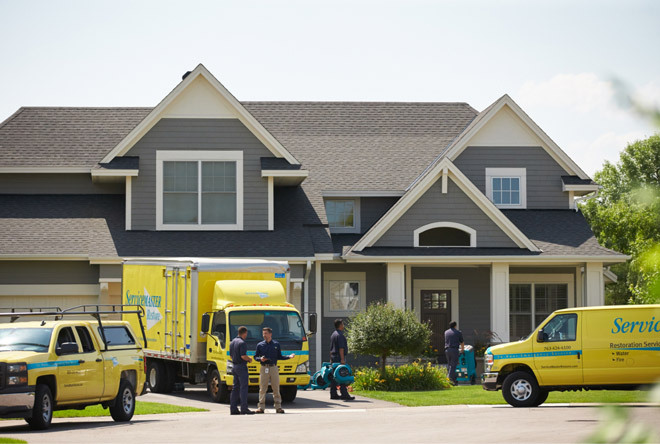Flood and Water Damage Restoration – Stafford, TX | Fort Bend County
ServiceMaster Restoration & Cleaning - Call: (281) 503-5189
Standing water or excess moisture that is present in your home or building can cause a significant amount of damage if not treated in a timely matter. Water damage can be caused by natural factors, such as heavy rainfall or flooding, or internal factors like burst pipes, leaking, overflows, and water backup. In as little as 48 hours, untreated or poorly treated water damage can lead to property and structural damage as well as trigger the development of mold growth. It is crucial to contact a professional water damage restoration service to properly dry, clean, and restore the damage caused by the water. ServiceMaster Restoration & Cleaning provides professional water damage restoration services to homes and businesses in Stafford and Fort Bend County, TX. Our professional IICRC certified technicians are prepared to address water damage of any size and fully restore the damage.
Trusted Flood and Water Damage Restoration
When standing water comes into contact with porous building materials like drywall, wood, insulation, and flooring, these materials can absorb the water and lead to property damage. This damage includes warping, discoloration, swelling, and possible mold growth. Over time, the damage to these building materials will cause them to weaken and increase the risk of structural collapse. The development of mold can also lead to further structural damage as well as cause severe allergic reactions to anyone exposed to it. Upon arrival, our professional technicians will act quickly to contain the water and prevent it from spreading further throughout the property. Next, they will prepare a full assessment of the overall damage in order to devise a customized restoration plan. We will use water extraction equipment to thoroughly remove any standing water and excess moisture from the affected areas. Then we will use advanced drying and dehumidification equipment to effectively dry any furnishings and building materials exposed to the water. Finally, we will completely clean and sanitize the affected areas using powerful anti-microbial cleaning solutions. Our professional water damage restoration services include:
- Prompt Emergency Response 24/7
- Free Inspections and Consultation
- Mold Removal
- Water Extraction and Dehumidification
- Moisture Monitoring
- Carpet and Upholstery Cleaning
- Sanitization and Anti-Microbial Applications
- Air Quality Control
- Content Cleaning and Pack-Out
- Assistance with Insurance Claims
Water Damage Restoration Response Tips
Prompt response to water damage is crucial in limiting the overall damage from spreading further. Below are some tips on how to immediately respond to water damage upon discovery.
What to DO:
- Open doors and windows, if weather permitting, to increase air flow through the home or building and help dry the affected areas.
- Remove area rugs and other temporary flooring.
- Move fragile objects like paintings and photos to a safe area.
- Use a coat hanger to keep draperies and curtains from touching the wet floor.
- Use a mop to remove or blot dry affected areas.
- Wipe excess water from furniture and put aluminum foil under furniture legs to prevent damage to the carpet.
- Tightly pack water damaged books together to prevent the pages from warping. Our professionals can restore the damaged books with a specialized restorative process.
- Do not use a standard vacuum cleaner to try to remove excess water.
- Do not try to remove mold or mildew yourself.
- Do not touch the water if you suspect it may be contaminated with sewage.
- Do not enter a room with standing water if the electricity is still on.
- Do not use electrical appliances that may be water damaged or are sitting on wet flooring.
- Do not try to remove permanent flooring or carpeting on your own.
Water and flooding can cause serious damage to furnishings and building materials if not addressed as soon as possible. ServiceMaster Restoration & Cleaning is available 24/7 to respond to emergency water damage situations in Stafford and Fort Bend County, TX.
If your home or building is experiencing water damage, contact us at (281) 503-5189 for our professional water damage restoration services.


